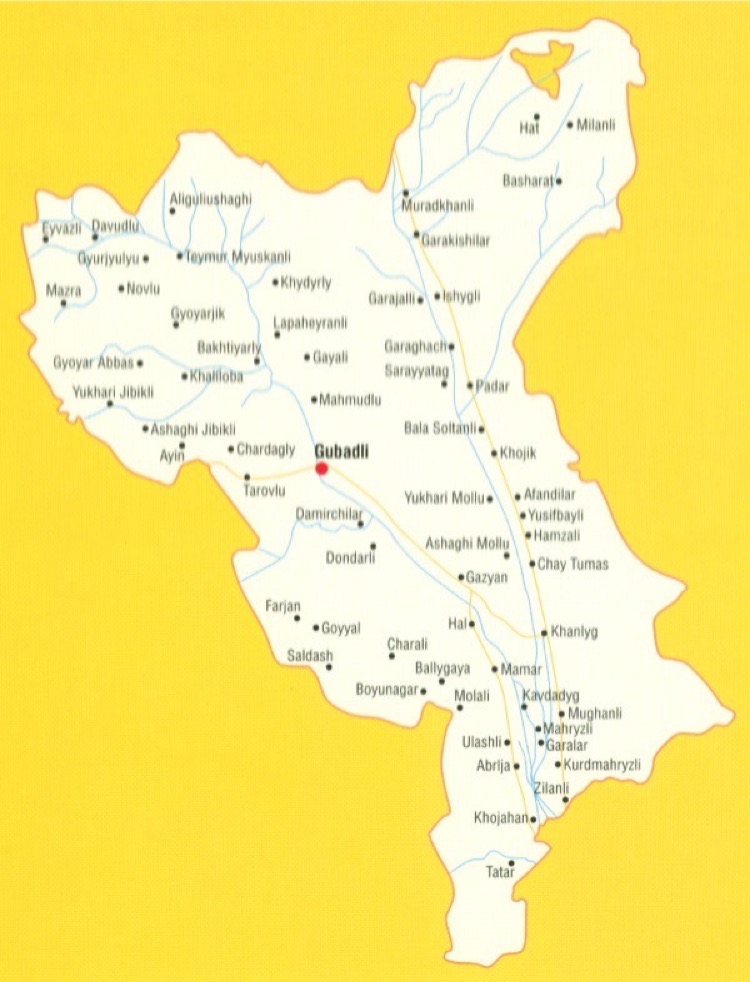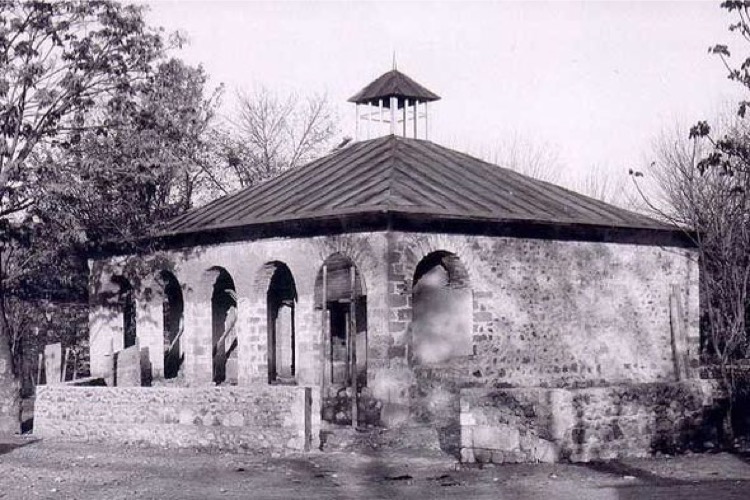Gubadly district is the administrative district of the Republic of Azerbaijan. It is located in the south-western part of the Minor Caucasus. In the west, it neighbors with the Republic of Armenia. Its area is 800 km2; the population is 41,600 (01.01.2020). The central town is the city of Gubadly. The region was occupied by the Armenian army on August 31, 1993. The Azerbaijani army liberated Gubadly city and 41 villages of the district from September 27 till November 9, 2020.
The district covers the followings: Gubadly city and villages of Aliguluushaghi, Mahmudlu, Sariyatag, Khanlig, Gayali, Lepeheyranli, Abdalanli, Dondarli, Dileli Muskanli,Saray, Mirler, Demirchiler, Poladli, Ferjan, Goyyal, Hertis, Zor, Ashaghi Khojamusakhli, Mehrili, Hal, Gazyan, Memer, Mollali, Balligaya, Jereli, Boyunegher, Saldash, Garalar, Kavdadig, Huseynushaghi, Ulashli, Altinja, Abilja, Tatar, Garagoyunlu, Ghiyasli, Zilanli, Kurd Mahrizli, Seleli, Mahrizli, Alagurshagli, Muganli, Hamzali, Chaytumas, Efendiler, Yusifbayli, Khojahan, Tinli, Ghilijan, Yukhari Mollu, Ashaghi Mollu, Mollaburhan, Khochik, Mardanli, Balasoltanli, Padar, Garamanli, Garachalli, Garagagh, Garakishiler, Basharat, Milanli, Hat, Deshdahat, Armudlu, Chardagli, Tarovlu, Khalach, Ayin, Goyerchik, Bakhtiyarli, Goyar Abbas, Chilfir, Seytas, Novlu, Gurchulu, Dovudlu, Ghedirli, Mazra, Eyvazli, Teymur Muskanli, Balahasanli, Khidirli, Ashaghi Jibikli, Yukhari Jibikli, Kheliloba, Muradkhanli Hekeri, Ishigli, Khendek, Malikahmadli and Gundanli.
Prior to the occupation, 62 secondary schools, the library, the club, 4 hospitals and others were at the service of local population. The district also had such architectural monuments as the Prayer Cave (4th century), fortresses (5th century), the turbehs (14th - 16th centuries), the mosque (19th century), the bridge (1867) and others.
Haji Badal Bridge
The bridge was built on Agha River by the resident of Damirchilar village - a person having an innate talent Haji Badal. Special ornamental stone, lime and egg yolks were used in construction of the bridge. The bridge linked 15 villages to the region center.
The bridge is an interesting piece of architecture. The vaulted bridge has no piers in the central part. The purpose of such a construction was to facilitate the unobstructed water flow of the overflowing mountain river.
This historical monument remained as it was until the occupation of Gubadly district.
Gubadly district was liberated from occupation in 2020.
History and Ethnography Museum of Gubadly Region
History and Ethnography Museum of Gubadly district was opened on May 6, 1980. Until 1993, the museum contained over 5000 exhibits. The museum pieces included ancient swords, daggers, copper utensils, pottery dishes, rare specimens of nature, fauna and flora, also the items belonging to the participants of the Great Patriotic War. There was also a separate corner for outstanding writers, scientists, culture and art figures in the museum. Their works, personal belongings were exhibited in that corner. Personal items that belonged to the folk heroes Gachag Nabi and Hajar, also the paintings depicting their heroic exploits were also kept in the museum.
In 1993 the Gubadly district was occupied by the Armenian Armed Forces. Gubadly district was liberated from occupation in 2020.
Lalazar Bridge
The bridge is located in Aliguluushaghi village of Gubadly district. The amazing masterpiece of architecture - Lalazar Bridge was built in 1867. The lower part of the bridge is oval, the upper part is plain. Both piers of Lalazar Bridge stick to the high rocks. Some researchers suggest that the bridge was built in the 18th century. The bridge of 2.8 meters in width and 5 meters in length is located 4.5 meters high above the water surface.
Gubadly district was liberated from occupation in 2020.
Mosque in Mamar Village
The mosque was built in the 18th century in Mamar village of Gubadly district. It was used as a warehouse building during the reign of the Soviet Power. After the restoring of independence that mosque was reconstructed and regained its original function. The mosque was destroyed after the occupation of the Gubadly district by the Armenian Armed Forces.
On October 30, 2020 Mamar vilage was liberated from occupation.
Tombs in Damirchilar Village
There are two tower-shaped tombs in the territory of Damirchilar village of Gubadly district. One of them is located on the right bank of the mountain river Aghachay. The shape of the tomb is octagonal (one side is 1.9 m). Inside of the tomb there is a small sanctuary niche built in the wall opposite the door. The interior walls were faced with good-hewn stone plates. The inner height of the tomb is 4.5 m.
All exterior sides of the tomb were built in the shape of shouldered shallow arches typical for Arazboyu tombs of the Elkhanids’ period. Small windows were set in the middle of the eastern and western niches.
The door is at a height of 1.2 m above ground level. Being 5 m high, the prismatic drum of the tomb was covered with an octahedral pyramidal dome. The space between that dome and the inner spherical dome was filled with big empty pitchers.
The second tomb is located near the right-bank slope of the river Aghachay, between Damirchilar and Dondarli villages. Due to its advantageous position, the tomb is well seen even from a remote distance. It has an octagonal shape as well (one side is 2.3 m on the outside and 1.40 m on the inside). By building material, construction engineering and architectural decision, this monument is identical to the first tomb. Except that dimensions of the first tomb are a little bigger (the inner size of the upper camera is 6.2 m, the height of the body is 6.90 m) and the shape of shouldered shallow niches in the inner walls is different from that of the first tomb. Both of these tombs are considered to be the monuments dated back to the 13th-14th centuries.
At present there is no any information about those shrines currently remaining under occupation.
Gubadly district was liberated from occupation in 2020.
Immovable historical and cultural monuments of state importance
ARCHITECTURAL MONUMENTS
Name of the monument |
Construction date |
Location |
Goy fortress |
5th c. |
Aliguluushaghi village |
Lalazar bridge |
1867 |
Aliguluushaghi village |
Mausoleum |
17th c. |
Gurjulu village |
Mausoleum No.1 |
14th c. |
Damirchilar village |
Mausoleum No. 2 |
14ht c. |
Damirchilar village |
Immovable historical and cultural monuments of local importance
ARCHITECTURAL MONUMENTS
Name of the monument |
Construction date |
Location |
Spring |
19th c. |
Aliguluushagi village |
Spring |
|
Aliguluushagi village |
“Galali" fortress |
|
Aliguluushagi village |
“Galali” fortress |
5th c. |
Muradkhanli village |
Shirin spring |
|
Mamar village |
Spring |
19th c. |
Damirchilar village |
Madat spring |
19th c. |
Mahmudlu village |
Mosque |
19th c. |
Damirchilar village |
Mosque |
19th c. |
Dondarli village |
Hajibadal bridge |
|
Dondarli village |
Mausoleum of Javanshir |
14th c. |
Yazi plain |
“Galajid” fortress |
|
Khojamusakhli village |
Mausoleum |
18th c. |
Khojamusakhli village |
Mosque |
18th c. |
Yusifbayli village |
Mausoleum |
18th c. |
Boyunagar village |
Mosque |
18th c. |
Mollali village |
Mosque |
18th c. |
Mirlar village |
Mosque |
18th c. |
Mamar village |
Ruins of the mosque |
15th-16th cc. |
Khalaj village |
Temple |
|
Mazra village |
Mosque |
19th c. |
Mahrizli village |
Bridge |
19th c. |
Mahmudlu village |
SAMPLES OF DECORATIVE-APPLIED ARTS (monuments of people art of stone-monuments)
Name of the monument |
Construction date |
Location |
Figure of stone sheep |
15th c. |
Mahmudlu village |
Stone chest |
9th-10th cc. |
Mamar village |





